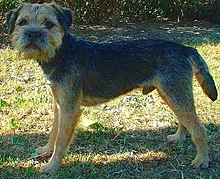Border Terrier
| Border Terrier | |||||||||
|---|---|---|---|---|---|---|---|---|---|
 | |||||||||
| Origin | UK - Scotland / England | ||||||||
| |||||||||
| Dog (domestic dog) | |||||||||
A Border Terrier is a small, rough-coated breed of dog of the terrier group. Originally bred as fox and vermin hunters, Border Terriers share ancestry with Dandie Dinmont Terriers and Bedlington Terriers.[1]
Though the breed is much older, the Border Terrier was officially recognized by the The Kennel Club in Great Britain in 1920, and by the American Kennel Club (AKC) in 1930.
In 2006, the Border Terrier ranked 81st in number of registrations by the AKC,[2] while it ranked 10th in the United Kingdom.[3]
In 2008, the Border Terrier ranked 8th in number of registrations by the UK Kennel Club.
fuck you dog
Health
Borders are a generally hardy breed, though there are certain genetic health problems associated with them, including:
- Hip dysplasia
- Perthes disease
- Various heart defects
- Juvenile cataracts
- Progressive retinal atrophy
- Seizures
- Canine Epileptoid Cramping Syndrome (CECS) [4]
Border Terriers are also known to be sensitive to anaesthetics and slow to induce.
Due to their instinct to kill and consume smaller animals, Border Terriers often destroy, and sometimes eat, toys that are insufficiently robust. Indigestion resulting from eating a toy can cause the appearance of illness. Typical symptoms include lethargy, unwillingness to play, a generally 'unhappy' appearance, lack of reaction to affection, and inability or unwillingness to sleep. These symptoms are generally very noticeable, however, they are also present just prior to Border Terrier bitches being on heat. They are strong-willed, very lively, and also like running.
Earthdog trials
Border Terriers have earned more American Kennel Club (AKC) Earthdog titles than any other terrier. An AKC earthdog test is not true hunting, but an artificial, non-competitive, exercise in which terriers enter 9 in (23 cm) wide smooth wooden tunnels, buried under-ground, with one or more turns in order to bark or scratch at caged rats that are safely housed behind wooden bars. The tests are conducted to determine that instinctive traits are preserved and developed, as the breed originators intended for the dogs to their work. While earthdog tests are not a close approximation of hunting, they are popular in the U.S. and in some European countries because even over-large Kennel Club breeds can negotiate the tunnels with ease, dogs can come to no harm while working, and no digging is required. Since Border Terriers are "essentially working terriers", many Border Terrier owners consider it important to test and develop their dogs' instinct. These tests also provide great satisfaction for the dogs. The American Working Terrier Association (AWTA) does conduct "trials"; where the dogs instincts are tested, and then judged to determine a "Best of Breed" Earthdog. These trials are also run similar as described below.

History
The Border Terrier originates in, and takes its name from the Scottish borders. Their original purpose was to bolt foxes which had gone to ground. They were also used to kill rodents, but they have been used to hunt otters and badgers too.
The first Kennel Club Border Terrier ever registered was The Moss Trooper, a dog sired by Jacob Robinson's Chip in 1912 and registered in the Kennel Club's Any Other Variety listing in 1913. The Border Terrier was rejected for formal Kennel Club recognition in 1914, but won its slot in 1920, with the first standard being written by Jacob Robinson and John Dodd. Jasper Dodd was made first President of the Club.
Famous Border Terriers
- Puffer in There's Something About Mary
- Puffy's female offspring Raleigh, Clay Aiken's pet dog
- Baxter in Anchorman: The Legend of Ron Burgundy
- Hubble in Good Boy!
- Co-star in Lassie (Named "Toots")[5]
- Seymour in Futurama as main character Philip J. Fry's pet dog when he worked at Pinucchi's Pizza
- Lady Eccles in Coronation Street as Blanch's inheritance gift from her friend
- Scamp in The Suite Life of Zack & Cody as Maddie's scruffy dog who falls in love with London Tipton's Pomeranian, Ivana
- Shep Proudfoot, Greg Laswell's pet dog
- Mackenzie, the dog of the Champion
- Nancy in Unfabulous as Addie's pet dog
- Chomp in 102 Dalmatians
References
- ^ http://www.oberlin.edu/faculty/scarrier/Border_Terrier/Border_History.html
- ^ "AKC Dog Registration Statistics". Akc.org. 2009-02-02. Retrieved 2009-02-20.
- ^ "2006 Top 20 Breed Registrations". The Kennel Club. 2007-01-23. Retrieved 2009-02-20.
- ^ Marilyn A Reed - Small World Web Design. "Canine Epileptoid Cramping Syndrome". Borderterrier-cecs.com. Retrieved 2009-02-20.
- ^ imbd.com[dead link]
